HIGHLIGHTS
PROGRAM UPDATES
AWC, WoodWorks, and ICC Co-Brand New Heights & Areas Calculator Think Wood’s New Pro Center Creates One-Stop Resource for Contractors Third-Party Sources Increasingly Feature Think Wood Content With WoodWorks’ Support, First CLT Office Building Erected in FloridaINDUSTRY NEWS
WoodWorks Steadily Grows Nationwide Reach #forestproud Stirs Pride in Industry’s Greatest Resource: Its People London-Based Designer Combines Timber and Fully Automated Construction New USGBC Campaign Stresses People as Main Beneficiaries of Green Communities Climate Change Mitigation Among Mass Timber’s Many Benefits, According to BBC Google Ups Its Role in Bay Area Housing Market Preference to Rent Changing the Way Communities Build Average New Home Size Shrinking in United States British Columbia Foresters Choosing New Trees to Adapt to Climate Change Demand Surges for Single-Family Rentals in Texas Kiplinger Letter Draws Attention to Widespread Shortages in Housing MarketProgram Updates
AWC, WoodWorks, and ICC Co-Brand New Heights & Areas Calculator
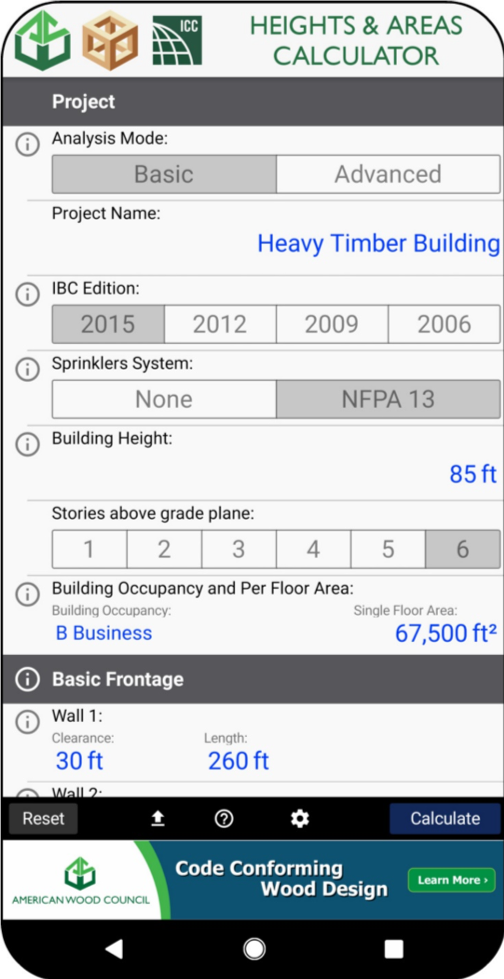
The International Code Council (ICC) has joined the American Wood Council (AWC) and WoodWorks in co-branding a new Heights and Areas Calculator mobile app, which is available for download free on Android, iOS, and Windows platforms.
By inputting a building’s geometry, site conditions, type of construction, and occupancy, the app can quickly calculate its maximum heights and areas based on 2006 to 2015 editions of ICC’s International Building Code (IBC). A user can input a single occupancy and equal floor areas for an entire building or, using an advanced setting, indicate multiple occupancies and different floor areas.
Previously, determining allowable heights and areas for building code compliance was often a tedious and time-intensive task for designers, builders, and code officials. The availability of this free, easy-to-use app will streamline the process of identifying compliant types of construction and allow for quicker specification by designers and easier confirmation of permitted wood construction by building officials.
For links to this and other time-saving AWC apps, click here.
Think Wood’s New Pro Center Creates One-Stop Resource for Contractors

Think Wood has launched a comprehensive, online Pro Center to provide residential contractors with a one-stop shop for inspiration, tools, and resources to plan and implement their exterior and interior projects using wood. The user-friendly Pro Center includes sections on project ideas, planning, selecting wood species, lumber grades and treatments, and practical design and calculation tools. Woven throughout are attractive images of finished projects that illustrate the beauty and possibilities of building with wood indoors and out.
Pro Center content is strengthened by the expertise and resources of partnering species associations, including the respective Northeastern and Southeastern Lumber Manufacturers Associations, Southern and Western Forest Products Associations, and Western Red Cedar Lumber Association.
Visit the Pro Center today to learn more, and spread the word about this valuable new resource.
Third-Party Sources Increasingly Feature Think Wood Content
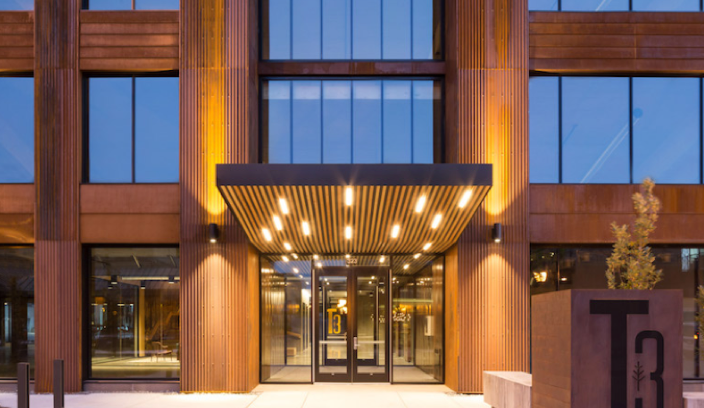
Videos and content produced by Think Wood are increasingly being featured on and linked to by external building and design resources, a testament to the quality and integrity of the communications products that Think Wood puts forward to promote the value proposition of softwood lumber.
The online platform BuildingConnected, a subsidiary of Autodesk, is a recent example of this trend. BuildingConnected acts as a preconstruction tool for general contractors to help them find vendors, qualify subcontractors, and manage bid processes for their projects. BuildingConnected also features a popular blog that covers trending topics in the building industry. This blog recently ran a post titled “5 Projects That Prove Mass Timber Is Here to Stay,” which featured an embedded Think Wood video profiling various next-generation engineered wood and lumber products, including cross laminated timber (CLT), and their use in low- and mid-rise non-residential applications.
Third-party websites linking to Think Wood strengthen the credibility and exposure of Think Wood.com as a dependable and comprehensive online resource.
With WoodWorks’ Support, First CLT Office Building Erected in Florida
Fifty West Realty of Clermont, Fla., was founded with the intent of bringing outstanding Class A office space to central Florida. The Fifty West team was considering mass timber among other structural materials for its first project. To learn more, the team made plans to attend a WoodWorks seminar and, impressed, then sought out WoodWorks’ technical advice as it considered the conceptual renderings and how wood might be used.
WoodWorks supported the resulting project—Fifty West at Plaza Collina—from its earliest stages by reviewing schematic plans, helping the team to understand the structural design options, introducing potential suppliers, and contributing to production meetings. Project partners, Powell Studio Architecture and Gutherman Engineering, were local to the area, but neither had mass timber experience. Recognizing that unfamiliarity with mass timber can increase costs and affect the availability of qualified erectors, WoodWorks also provided assistance in procurement processes, educating and finding potential contractors, and presenting information to ensure that building and fire officials were fully appraised of CLT’s performance capabilities.
Now under construction, the 28,800-square-foot Fifty West at Plaza Collina is the first CLT building in Florida and includes two stories of Class A offices over retail and restaurant space on the ground floor. The building is set to consume the equivalent of 691,200 board feet of softwood lumber.
Industry News
WoodWorks Steadily Grows Nationwide Reach
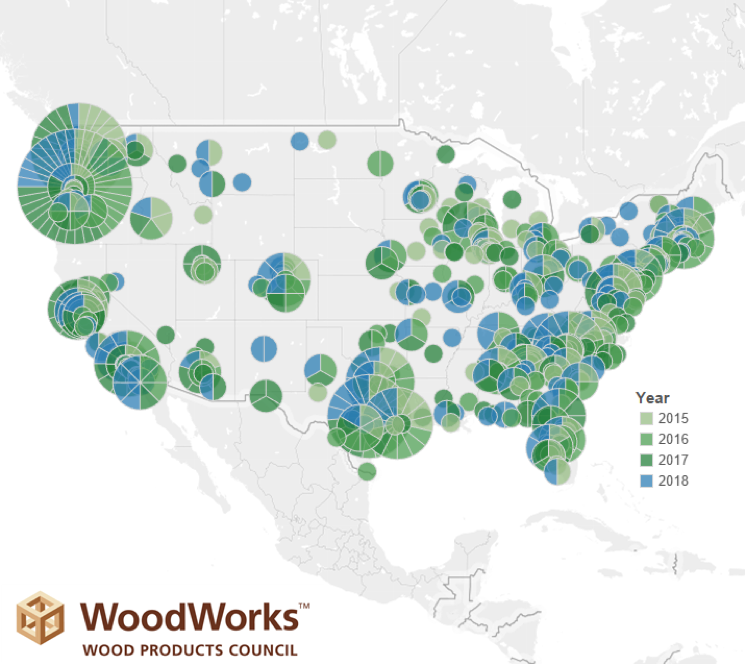
WoodWorks increases the use of softwood lumber in non-residential and multifamily buildings through expert, free project assistance and education and technical resources.
WoodWorks staff successfully converted 1,050 projects from 2015 through 2018 across 48 states, including the District of Columbia, achieving anywhere from 9 to 13% growth year-on-year across that time. The greatest number of completed conversions were in California and Texas, where strong demand has resulted in WoodWorks’ increased staff capacity. Washington state and North Carolina are also perennially near the top of list of locations with converted projects, with both markets serviced by highly experienced WoodWorks staff.
The length of WoodWorks’ tenure in a region appears to correlate strongly with its success. It often takes several years to earn the trust of peers locally and position WoodWorks as the go-to expert in a region.
#forestproud Stirs Pride in Industry’s Greatest Resource: Its People
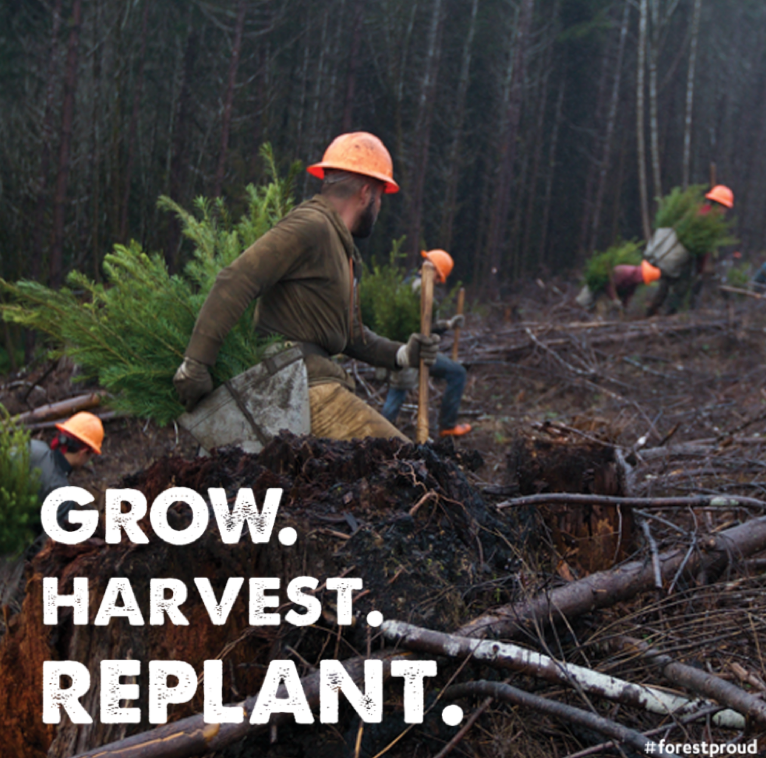
Without uttering a word, #forestproud’s newest video spurs a tremendous sense of pride in and respect for the men and women who—through a diversity of jobs—power the softwood lumber industry.
Watch the video and be inspired here.
London-Based Designer Combines Timber and Fully Automated Construction
London-based Gilles Retsin Architecture and the Design Computation Lab have introduced “Real Virtuality,” an algorithmically designed, modular installation intended to showcase how virtual technologies can support the fabrication of flexible, low-cost timber structures.
Real Virtuality was built using Microsoft’s HoloLens augmented-reality technology and robotics. Retsin specified softwood lumber based on its sustainability qualities, strength, and cost-efficiency. According to Retsin, “It’s becoming more and more clear that timber will be one of the most important materials for construction in the 21th century. . . . The emphasis is often on the sustainable aspects of timber, but what is underestimated is also the degree to which timber construction can be automated and therefore reduce the cost of construction.”
Learn more about the Real Virtuality installation here.
New USGBC Campaign Stresses People as Main Beneficiaries of Green Communities
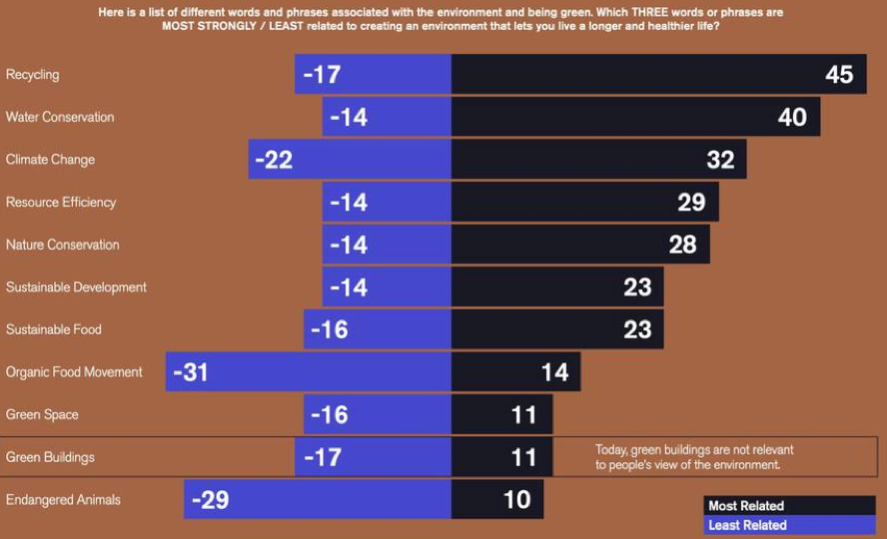
The U.S. Green Building Council (USGBC) has launched a new, human-centric campaign called Living Standard to build a vision for a more sustainable future for all. The campaign focuses on making visible the tangible and positive impacts that green buildings and communities have on people’s lives.
USGBC initiated the campaign with an intensive research phase, which showed that a majority of Americans do not see green buildings as relevant to their view of the environment or climate change. Yet, the impacts of the built environment—including housing, offices, and cities—continue to have real and negative effects on people’s life expectancies and health across the United States and world. By focusing on people, Living Standard intends to show how green buildings can raise the quality of life of individuals, families, and communities everywhere.
This reinforces the position that while it is important for the SLB to leverage and incorporate environmental messaging, including wood’s benefits in helping tackle climate change, it is imperative that for the industry to be successful we need to take a pragmatic approach and clearly communicate the “what’s in it for me” value proposition
Read more about Living Standard here.
Climate Change Mitigation Among Mass Timber’s Many Benefits, According to BBC
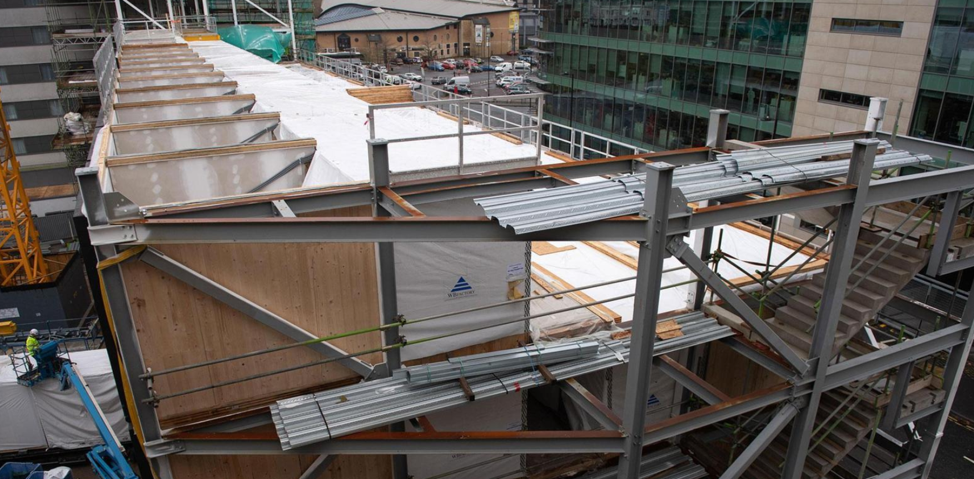
The BBC recently explored the extent to which wooden buildings can contribute to the fight against climate change, particularly in comparison to concrete and steel, whose use comes at a severe environmental, and thus human, cost. The piece includes reflections by Andrew Waugh of London-based Waugh Thistleton architects, who was the first to use CLT to construct a tall building—the nine-story Murray Grove, built in 2009—which effectively launched a still-rapidly growing wave of tall mass timber buildings. Having now built with CLT for a decade, Waugh believes that mass timber can achieve anything a concrete and steel building can and more.
The piece notes that mass timber’s multiple benefits have not been lost on U.S. government authorities. According to a U.S. Forest Service spokeswoman, “If we can build markets for these wood products, landowners will be more likely to sustainably manage or sustainably thin their land,” with CLT, in particular, having the potential to reduce “wildfire risk [and] support rural economic development and jobs.”
Read the BBC’s analysis here.
Google Ups Its Role in Bay Area Housing Market
Alphabet Inc.-owned Google has selected Australian developer and general contractor Lendlease as its primary partner for its ambitious $1 billion commitment to build 15,000 homes on its properties and 5,000 subsidized homes for low-income residents throughout the Bay Area.
As part of the deal, Lendlease will develop about 15 million square feet of residential, retail, hospitality, and other use units in new, ground-up neighborhoods in San Jose, Sunnyvale, and Mountain View over the coming 10 to 15 years. The components together have an estimated end-development value of $15 billion. Lendlease and Google anticipate starting construction on new developments as early as 2021, subject to planning approval.
Google, one of the Bay Area’s largest tech employers, is among the few private companies jumping into housing development, as the region’s housing costs soar thanks to housing production paling in comparison to job growth.
Read more about the Google-Lendlease partnership and their ambitious plan here. For the media release, see here.
Preference to Rent Changing the Way Communities Build
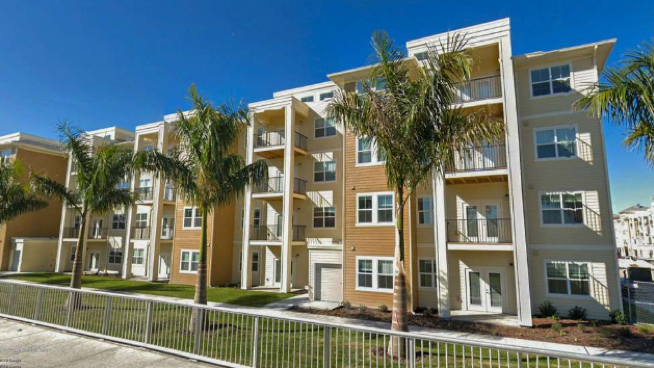
Over the past decade, a growing number of households have opted to rent by choice, not necessity, which is creating a new niche market for builders and developers of both single-family and multifamily homes.
On the single-family side, according to National Multifamily Housing Council data, 15 million households—representing 35% of renting households—rent single-family homes rather than multiunit apartments. Some analysts expect that the built-for-rent segment will grow from the low single digits of housing activity volume to a solid double-digit percentage of homes over the next decade. Developers are taking note, with, for example, luxury homebuilder Toll Brothers and BB Living, an established built-to-rent developer, recently entering into a $400 million joint venture to build and operate single-family rental communities.
Meanwhile, areas around Tampa Bay, Fla., demonstrate the renter effect on multifamily units. The area is experiencing a construction boom of wood-based apartment communities, with builders choosing stick-frame wood construction based on market forces. Wood is cheaper proportionally than masonry and concrete, and developers cannot charge rents high enough to justify more costly materials. Tampa’s new stick-frame units are typically made of strong, engineered wood products, outfitted with fire-protection measures, and capped at four stories, in accordance with code.
Read more about the growing influence of renters here and here.
Average New Home Size Shrinking in United States
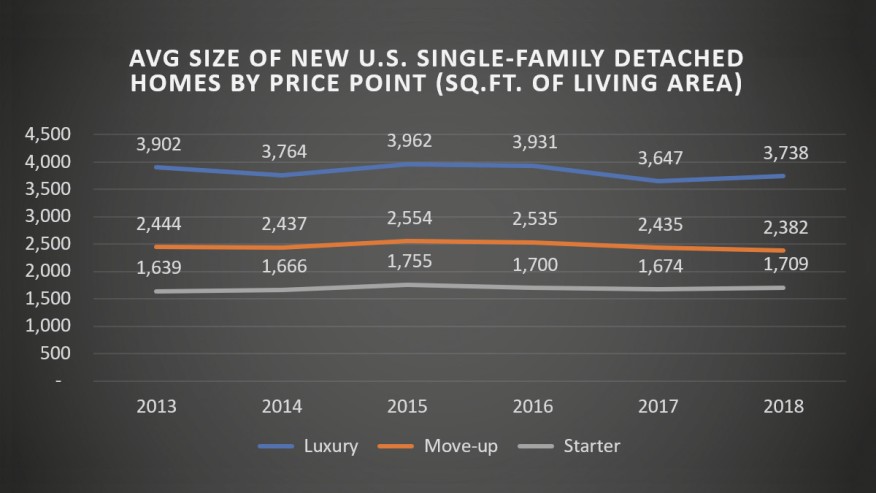
Home Innovation’s 2019 Builder Practices Survey of more than 1,500 U.S. homebuilders reiterated recent U.S. Census reporting—the average new home size in the United States is in decline overall. This decline is attributed primarily to demographic changes and particularly the influx of younger people into the share of those purchasing new homes. This has resulted in more starter homes being constructed and purchased than move-up homes in recent years. The survey also registered a minor decline in average size of builder-defined luxury homes, and a modest increase in the average size of starter homes.
The overall impact of the decline in home size has numerous trickle-down effects on component markets, including those of the softwood lumber industry. For example, the survey noted that treated wood decking and exterior hand railing gained at the expense of cedar and redwood; composite decking gained slightly; and flooring continues to go more upscale, particularly hardwood and ceramic tile.
Read more about survey results here.
British Columbia Foresters Choosing New Trees to Adapt to Climate Change

Foresters in Revelstoke, a city in southeastern British Columbia, are changing the way they replant cut forest blocks in anticipation of a warmer climate. As of 2018, provincial reforestation regulations allow foresters to order their saplings according to climatic, not geographical, matches. This means they are now able to access and plant trees that come from seeds harvested in and suitable for slightly warmer climates. The program selects trees that have an optimal temperature of 1.5 degrees Celsius higher than the location in which they will be planted; this will allow the trees time to establish themselves, particularly in the first quarter of their lifetime when they are most vulnerable. According to Greg O’Neill, climate change–adaptation scientist at the Kalamalka Forestry Centre, “By doing this, we hope to set trees up for the best possible chance of success in an uncertain climate future.”
Read more about this effort here.
Demand Surges for Single-Family Rentals in Texas
A growing number of Texas builders are moving into the single-family rental home market as demand from consumers surges.
According to Mark Wolf, the founder and CEO of one such firm, AVH Communities, “We basically took an apartment and went horizontal instead of vertical. . . . About 93% of the apartment stock consists of studios, one and two bedrooms, very few three bedrooms. We saw a growing need, coming out of the (economic) downturn, to provide three- and four-bedroom homes to the renter society.” AHV Communities is currently partnering with Bristol Group to build a gated community of 250 new, three- and four-bedroom detached homes in San Antonio, which are expected to rent for $1,800 to $2,300 per month. The community also includes luxury amenities common in multifamily units, such as a pool, fitness center, and party space.
Last year, about 43,000 single-family homes were built for rent, the largest number in nearly 40 years according to the U.S. Census. The built-for-rent share of housing starts is also rising, nearly double its recent historical average (1992-2012). Baby boomers and millennials are the main drivers of market growth.
Read more about this fast-growing trend here.
Kiplinger Letter Draws Attention to Widespread Shortages in Housing Market
On July 26, the renowned Kiplinger Letter turned its attention to the U.S. housing market with one word: Shortages. Kiplinger noted shortages in homes for sale, buildable lots, construction workers, and affordable housing, especially for first-time buyers.
These shortages occur against a backdrop of record-high pricing, which as Kiplinger notes, simply puts homeownership out of reach for many buyers, particularly in cities with stronger employment and earning prospects.
To increase housing supply, Kiplinger encourages builders to construct smaller homes, consistent with current consumer preferences, and government officials to rethink zoning laws to allow for the construction of more multifamily housing and accessory dwelling units.
Read more here.
Industry Resources
FEA Housing Dashboard
This housing dashboard is provided compliments of Forest Economic Advisors (FEA)
Virginia Tech’s Monthly Housing Report
This monthly housing commentary report is a free service of Virginia Tech and is intended to help one gauge future business activity in the U.S. housing market.
June 2019 Reports (released in July 2019)
Part A: June Housing Commentary
Part B: June Economic Conditions

